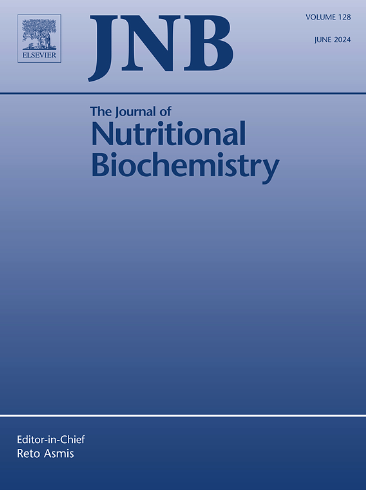红豆杉通过加合物形成抑制硒蛋白 P 的供硒功能
IF 4.8
2区 医学
Q1 BIOCHEMISTRY & MOLECULAR BIOLOGY
引用次数: 0
摘要
硒是一种强效亲核素,是谷胱甘肽过氧化物酶(又称 GSH-Px;GPX;GPx)和硒蛋白 P(又称 SelP;SEPP1;SELENOP;SeP)等硒酶所必需的。SeP 主要从肝脏分泌,在血浆中起硒载体的作用。我们之前发现,亲电植物化学物质 sulforaphane 可减少培养肝细胞和小鼠肝脏中 SeP 的产生,但 SFN 对 SeP 的亲电修饰对硒转运和代谢的影响仍不清楚。在本研究中,我们利用酸性生物素 PAEC5 马来酰亚胺标记法对硒代半胱氨酸残基进行了集中标记,结果表明苏拉环能共价修饰 SeP 的硒代半胱氨酸/半胱氨酸残基。虽然 SFN-SeP 加合物能被 HepG2 细胞吸收并被溶酶体降解,但它在诱导 GPx 表达方面的效果较差。我们的研究结果表明,SFN 通过形成 SeP-SFN 加合物破坏了硒的供应途径。本文章由计算机程序翻译,如有差异,请以英文原文为准。
Inhibition of selenium supply function of selenoprotein p through adduct formation by sulforaphane
Selenium is a potent nucleophile essential for selenoenzymes, such as glutathione peroxidase (also known as GSH-Px; GPX; GPx) and selenoprotein P (also known as SelP; SEPP1; SELENOP; SeP). SeP is predominantly secreted from the liver and functions as a selenium carrier in plasma. We previously found that sulforaphane (SFN), an electrophilic phytochemical, reduces SeP production in cultured hepatocytes and mouse liver, however, the effect of electrophilic modification of SeP by SFN on selenium transport and metabolism remains unclear. In the present study, we demonstrate that sulforaphane covalently modifies selenocysteine/cysteine residues of SeP using an acidic biotin PAEC5 maleimide labeling assay, which allows for focused-labeling of selenocysteine residues. Although the SFN-SeP adduct can be taken up by HepG2 cells and degraded by the lysosome, it was less effective in inducing GPx expression. Our findings indicate that SFN disrupts the selenium supply pathway through the formation of the SeP-SFN adduct.
求助全文
通过发布文献求助,成功后即可免费获取论文全文。
去求助
来源期刊

Journal of Nutritional Biochemistry
医学-生化与分子生物学
CiteScore
9.50
自引率
3.60%
发文量
237
审稿时长
68 days
期刊介绍:
Devoted to advancements in nutritional sciences, The Journal of Nutritional Biochemistry presents experimental nutrition research as it relates to: biochemistry, molecular biology, toxicology, or physiology.
Rigorous reviews by an international editorial board of distinguished scientists ensure publication of the most current and key research being conducted in nutrition at the cellular, animal and human level. In addition to its monthly features of critical reviews and research articles, The Journal of Nutritional Biochemistry also periodically publishes emerging issues, experimental methods, and other types of articles.
 求助内容:
求助内容: 应助结果提醒方式:
应助结果提醒方式:


